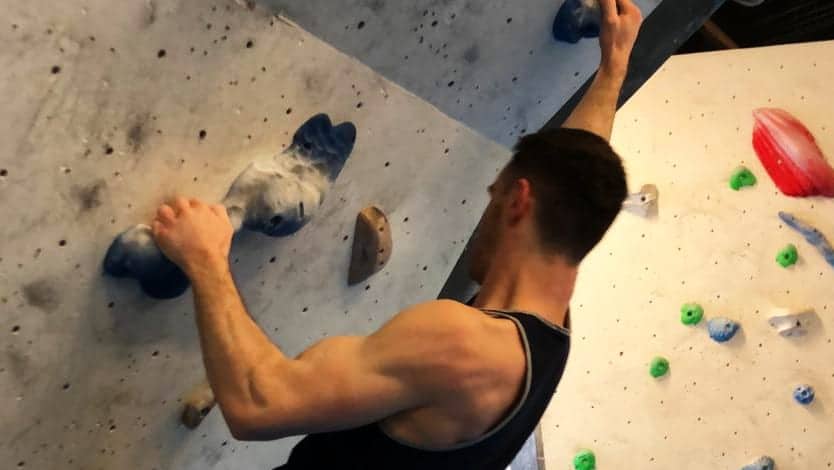
Before I started climbing I thought I was pretty strong. I’d done all sorts of different exercises from static to dynamic weight training, different types of martial arts – striking and grappling. I was quite a good grappler due to my upper body strength. So when I first got on the climbing wall I was surprised when I was finding it hard on my upper body, forearms and fingers. I was so sore for the next few days especially on the forearms and fingers. Now, after climbing for about a year and a half I still get the soreness, but I’m obviously a lot stronger in the areas that it matters.
So, is climbing a good workout? Whether you’re bouldering, rock climbing, indoor climbing, or lead climbing, it’s safe to say that climbing is a good workout. It’s thought that it could be one of the best full body workouts around. The muscle group you use most when climbing is your back, particular your lats. Other muscle groups used when climbing include upper and forearms, your shoulders, your calves and your abdominal muscles. It depends on the rock face or wall type on what muscles you will use most. For example, on slabs you will use your legs more than on an overhang. A study has shown that climbing is as good at affecting the heart rate and energy expenditure (cardio exercise) of an individual similar to that of running at 8-11 minutes per mile. Indoor climbing and outdoor climbing is pretty much the same in terms of how good a workout they are, there are small differences in what you’re gripping but overall it’s still a full body workout.
Read on for more information regarding the paragraph written above.
Page Jumps
- Muscle Groups Targeted When Climbing
- Different Types of Climbs Target Different Muscle Groups
- Is Rock Climbing Good Cardio?
- Training Exercises Similar to Climbing
- How Many Calories Do You Burn When Climbing?
- Can You Lose Weight By Climbing?
Muscle Groups Targeted When Climbing
Generally, most of your muscles are targeted when climbing; however there are some muscle groups that are disproportionately targeted over the others. These are your back, forearms, biceps and triceps, shoulders, calves and core. The main muscle group that climbing focuses on is the back area – specifically the ‘latissimus dorsi’ (the lats). This becomes obvious once you begin training as you’ll find the muscles around the different groups will be sore for a few days after you’ve been climbing. I’m going to go through each muscle within the muscle areas, but bear in mind that what type of climb you do will depend on what the main muscle group is that’s targeted. For example, climbing a slab and climbing an overhang will affect muscle groups in different ways.
Back
The back muscles are used to pull us up in climbing. If you’ve ever done a pull-up as an exercise before you’ll probably know it targets your latissimus dorsi which are your side-back muscles. They’re the big, wing-shaped muscles on your back.
Forearms
One thing you’ll definitely notice after a good climbing workout is sore fingers and forearms for the next few days. There aren’t many exercises we do day to day that require a massive amount of forearm or finger strength, however when it comes to climbing these play a vital role. There are some climbs that require you to have a certain amount of finger strength to complete. That’s why it’s good to train your finger strength and forearm strength using equipment such as fingerboards and finger trainers. Even hanging from a pull up bar by your fingers is better than nothing.
Biceps and Triceps
The biceps are located on the front of your upper arm and they contain two muscles, hence the name BI-ceps. The triceps are located on the back of your upper arm and they contain three muscles, hence the name TRI-ceps.
Climbing targets the biceps in a massive way. This is especially true for overhangs and steeper climbs. The biceps assist the lats when pulling the body upwards and tire out faster than the latissimus dorsi due to their size. The lats are much bigger than the biceps and therefore won’t fatigue as easily when they are both being used in an exercise.
The triceps aren’t targeted as much but are used in moves such as the ‘mantle’. This is when you use the palm of your hand to push yourself up towards your destination and it creates a similar motion to a triceps exercise.
Shoulders
The main muscles targeted in the shoulder area are your posterior deltoids. The posterior deltoids assist your lats as you pull yourself up the wall or towards the wall. They are mainly trained in conjunction with the lats and as you are mostly using the lats when you climb, the posterior deltoids will also be used a fair bit.
Calves
I usually find that slabs target the calves most mainly because of the balance and leg work that is required. That isn’t to say other climbs don’t target the calves, however. There are two muscles in the calves. These are the ‘gastrocnemius’ and ‘soleus’. When balancing on small foot holds with the tips of your toes, your two calve muscles are working to keep you up and stabilized. Once these muscles get tired they may start to shake.
Core
The abdominal muscles are used in climbing a lot more than you might think. This is due to the nature of climbing in terms of balance, finding your center of gravity and generally pulling yourself up a wall.
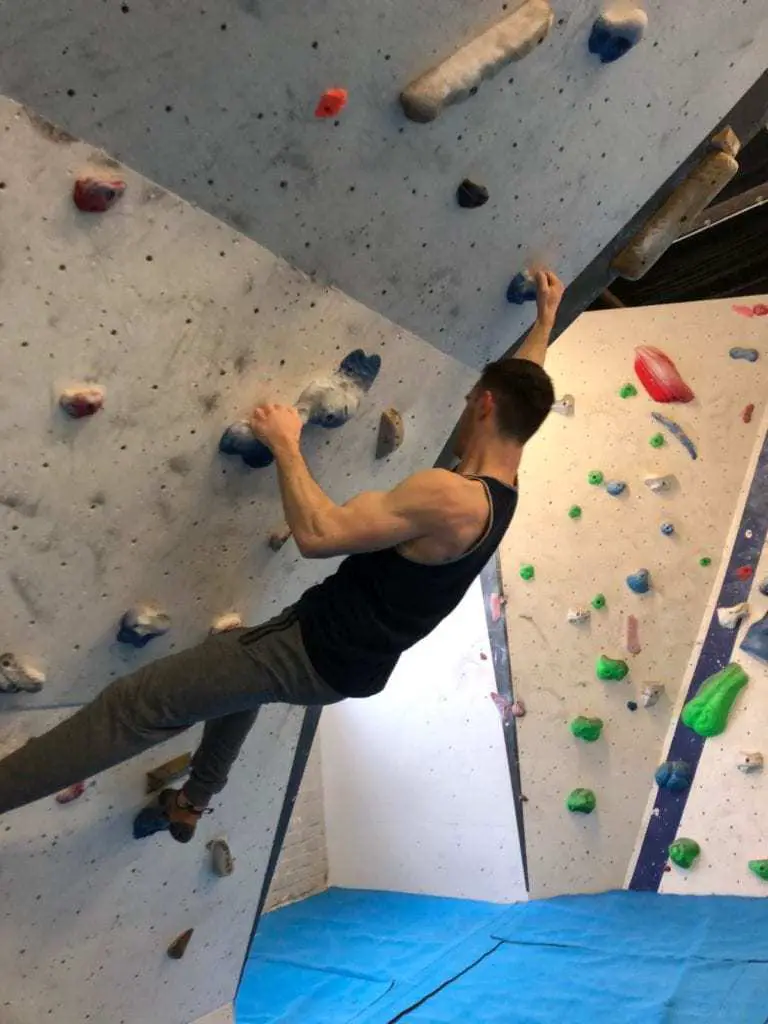
Different Types of Climbs Target Different Muscle Groups
We’ve already talked about how different types of climbs target different muscle groups but let’s delve a little bit deeper. There are three types of climbs in terms of the rock faces that are found in indoor and outdoor climbing. These three types of climbs are known as slabs, vertical climbs, and overhangs. All three types affect muscles groups differently but these three different rock faces will all target your lats. Different rock face angles affect muscle groups differently. It’s pretty obvious that if you are climbing a wall that is -60 degrees, it’s going to be a completely different climb and target different muscles than a climb that’s 60 degrees.
What is a slab?
Simply put, a slab is a rock face or climbing wall that is angled LESS than 90 degrees. This is known as an incline. Slabs require you to put a lot of weight on your feet and therefore engage your calf muscles. Your hands are arms are used to stabilize your body rather than pull you up as it’s your feet and legs that are doing most of the work.
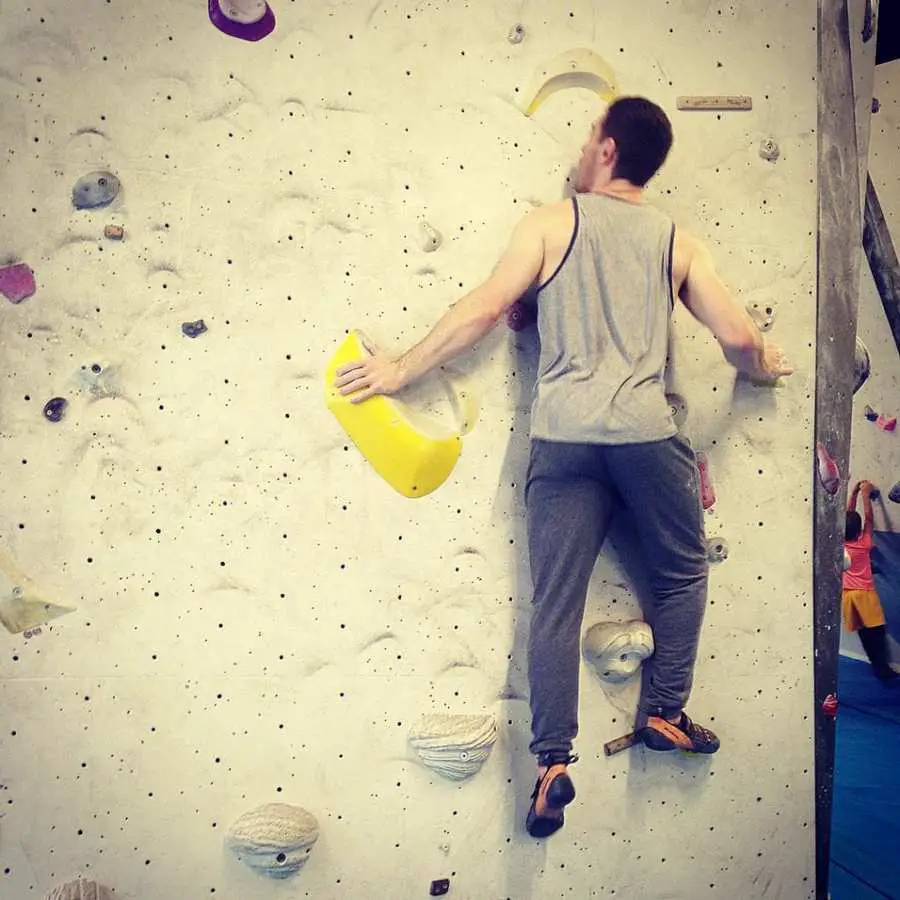
What is a vertical climb?
A vertical climb is a 90 degree climb, straight up. Vertical climbs are similar to slabs as they require you to use your feet a lot. However you will also need to pull up using your arms slightly more than on your average slab.
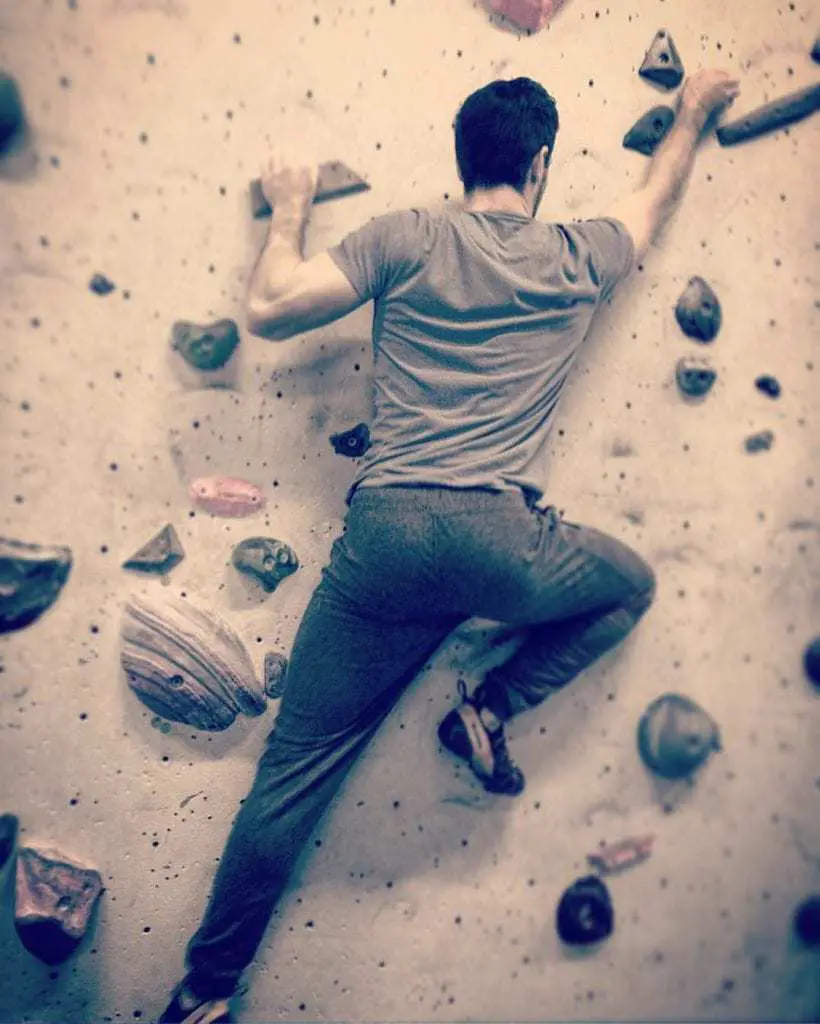
What is an overhang?
An overhang is a climbing wall or rock face that is angled MORE than 90 degrees. This is known as a decline. Upper body strength is required to climb an overhang, coupled with good technique. The more you can use your feet here with techniques such as ‘heel hooks’ the better as this will take the weight off your upper body and therefore fatigue is less likely to appear as fast. You’ll also be training your leg muscles more.

Is Rock Climbing Good Cardio?
Climbing works your cardiovascular system and your respiratory system. It’s a mediocre exercise in terms of cardio. This depends, however, on how fast you climb, of course and how much of a break you take in between climbs.
A study was conducted and published in the British Journal of Sports Medicine climbing in 1997 and can now be found on the NCBI website. The objective was “To report the physiological responses of indoor rock climbing”. It was found that indoor rock climbing affected the heart rate and energy expenditure of 14 different climbers similar to that of running at a pace of 8-11 minutes per mile. It was concluded that “These data indicate that indoor rock climbing is a good activity to increase cardiorespiratory fitness and muscular endurance.”
Training Exercises Similar to Climbing
Pull ups are probably the best exercises you can do to help you with overhang climbs. Pull ups target the main groups of muscles that are used when you climb. The latissimus dorsi are the main muscles used in pull ups and climbing. If you can also introduce muscle ups into your pull up routine, this will also benefit your climbing experience. If you prefer slab climbing or vertical climbs or just want to train the muscle groups that benefit those types of climbs then try introducing calf raises into your exercise regime. These can be done on a yoga block or some form of equipment that is raised above the floor. As mentioned previously, usually a fingerboard will also help your finger strength.
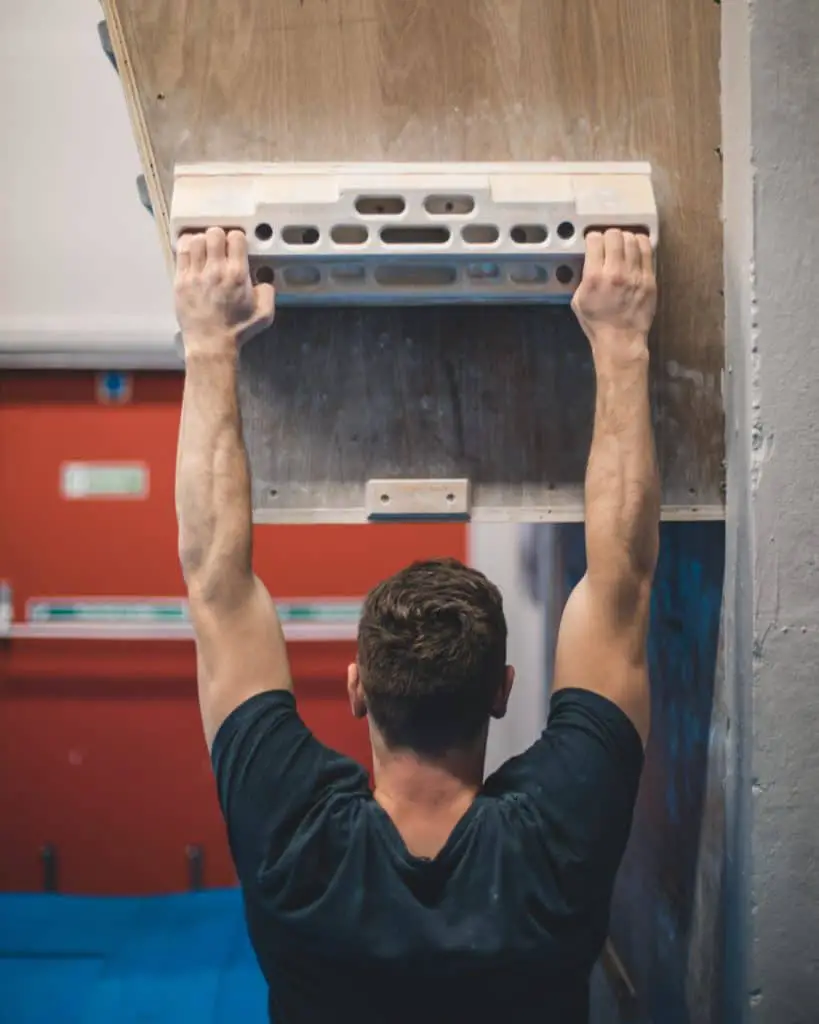
How Many Calories Do You Burn When Climbing?
It is thought that you burn around 500-900 calories per hour when climbing at a moderate to high rate. It obviously depends on how hard and fast you climb as to how many calories you burn. If you are climbing as a social experience and you are having 3-5 minute breaks, it’s quite obvious that you will burn fewer calories than if you were to only have a 1 minute break between climbs. It also depends on the type of climb you are doing. Overhangs typically burn the most calories because they are working larger muscles and require more strength, whereas slabs and vertical climbs are focused more on foot stability and balance.
Can You Lose Weight By Climbing?
You can lose weight by doing any exercise, including climbing. If you were to exercise and keep the same diet as you do now, there’s no doubt that you’ll burn fat. This is because you have increased the work load while keeping the energy intake the same. Here’s the secret to losing weight: LESS CALORIES IN, MORE CALORIES OUT. That’s it! No teatoxes, no skinny coffee, no diet pills! Just burn more calories than you put in. Therefore climbing can help you lose weight and it will burn fat… as long as you don’t increase the amount of calories you put in. Now if you’re trying to build muscle it’s a bit different; if you’re already overweight you probably won’t need to add anymore overall calories or carbs, however you may need to add more protein into your diet. A topic like that needs a whole article by itself, though!
